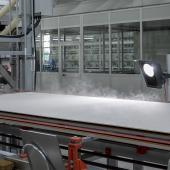Italian tile industry sees slowdown in 2018
Tile production dropped to 415 million sq.m (-1.6%), while the sector’s turnover fell by 3% to 5.4 billion euros. Investments in technology remained very high at more than 500 million euros.
Confirming the preliminary end-of-year results, the Italian ceramic tile industry experienced a downturn in 2018 for the first time after five years of uninterrupted growth. The result was revealed by the national statistical survey presented by the Chairman of Confindustria Ceramica Giovanni Savorani at the annual members’ meeting held on 11 June.
The 137 companies making up the Italian tile industry reported a 1.6% year-on-year decline in output to 415 million sq.m (a fall of 7 million sq.m), while total sales dropped by 2.8% to 410.1 million sq.m and total sales revenue fell by 3% to 5.4 billion euros.
Exports suffered the most from the weakness of demand, falling by 3% in terms of volumes (from 338 to 327.7 million sq.m) and 3.3% in value (to 4.547 billion euros) due to the difficulty in raising average price (stable at 13.9 €/sq.m) despite a higher value-added production mix.
Domestic sales continued to stagnate, dropping 1.6% to 82.4 million sq.m (less than half of the pre-crisis figure) and generating revenues of 834 million euros (-1%) thanks to an average price of 10.1 €/sq.m.
The tough challenges in export markets
As Mr Savorani explained, the increasingly fierce rivalry from other ceramic producing countries (Spain, China and in some markets now also India), the growing competition from alternative materials (particularly LVT) and the uncertainty caused by protectionist trade policies and the tariffs war between USA and China are some of the main causes of the slowdown in Italian tile exports.
In 2018 Italy succeeded in holding its ground in European markets, where it sold 222 million sq.m with a small fall in Western Europe and strong results in the Balkans.
Sales declined in other geographical areas: -5.4% in North America (46 million sq.m), -4.3% in the Far East (20 million sq.m), -21% in the Gulf states (9 million sq.m), -10% in North Africa and other Middle Eastern countries (10 million sq.m) and -6.8% in South America (4 million sq.m).
“The global scenario remains highly complex and it’s still too early to talk of a turnaround in 2019 despite the positive figure (+1.4%) for our exports in the first quarter of this year,” explained Savorani. “More than anything else we’re looking to consolidate our 2018 results.”
Manufacturing internationalisation of the Italian ceramic tile industry
The Italian ceramic industry is the world leader in terms of internationalisation of its manufacturing operations with no fewer than 16 foreign companies controlled by 9 Italian ceramic groups (Concorde, Dado, Del Conca, Florim, Gambini Group, Granitifiandre, Laminam, Panaria and Ricchetti), which produce tiles in production plants located mainly in the United States (30% of production outside Italy), Europe and Russia. Adding together production in Italy and abroad, the sector’s total output volumes amount to more than 500 million sq.m and exports to 414 million sq.m.
In 2018, Italian-owned companies operating outside Italy had a total workforce of 3,151 people and produced 85.8 million sq.m of tiles, in line with the levels of 2017.
The total sales volumes of 86.5 million sq.m generated a turnover of 858.91 million euros (-0.4%), 80% of which consisted of sales in the same country where the factory is located.
European sales rose to 483.2 million euros (+2.8%), while sales in North America fell by around 4% to 375.7 million euros. The US producers (including many owned by Italian groups) are increasingly concerned about the unfair trade practices adopted by the Chinese ceramic industry, leading to the presentation on 10 April of a petition to the US Dept of Commerce calling for the introduction of antidumping duties.
Employment and investments
While the market results were below the ceramic industry’s expectations, especially abroad, Mr Savorani pointed to two positive figures that give grounds for optimism regarding the sector’s prospects. The first is employment, which at the end of 2018 totalled 19,692 people (+0.9%, 177 more than the previous year). The second concerns investments, which outstripped the preliminary estimates and remained above the 500 million euro mark. Following the record sums of 400 million euros in 2016 and 515 million euros in 2017, investments in 2018 totalled 508.2 million euros, 9.4% of the sector’s turnover. This brought the figure for the industry’s total investments over the last five years to more than 2 billion euros. These investments were largely driven by the Industry 4.0 tax incentives aimed at modernising factories, a benefit that the tile sector has leveraged more effectively than other Italian industries for the purposes of improving competitiveness through the use of cutting-edge technologies.
Did you find this article useful?
Join the CWW community to receive the most important news from the global ceramic industry every two weeks




















